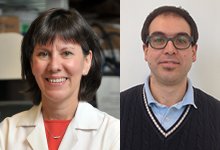Advancement in Stem Cell Research Makes Muscle Dystrophy Curable
 For the first time, scientists are able to generate both skeletal and cardiac muscle using the same stem cell population. The Northwestern Medicine study published in Nature Communications, in collaboration with an international group from the University of Leuven, suggests a potential treatment for muscular dystrophy.
For the first time, scientists are able to generate both skeletal and cardiac muscle using the same stem cell population. The Northwestern Medicine study published in Nature Communications, in collaboration with an international group from the University of Leuven, suggests a potential treatment for muscular dystrophy.
“The goal is to make stem cells more efficient at regenerating and improving both skeletal and cardiac muscle,” said Elizabeth M McNally, MD, PhD, Elizabeth J. Ward Professor of Genetic Medicine in the Division of Cardiology, and co-author of the study.
Recognizing skeletal muscles have some ability to regrow after injury, researchers have been exploring ways to promote muscle regenerative capacity to treat Duchenne muscle dystrophy, a genetic disorder characterized by degeneration affecting both the heart and skeletal muscle.
In this study, induced pluripotent stem cells (iPSC) derived from humans were injected into a dystrophic mouse model. IPSCs are stem cells that can be produced from cells obtained from skin, urine, or blood, providing a ready source of regenerative cells. To boost iPSC differentiation potential, researchers treated the cells with microRNAs before injection.
“A single microRNA can control the expression of a lot of different genes,” said McNally, who is also the director of Center for Genetic Medicine. Because promoting regeneration is complex, microRNAs are well suited to regulate multiple gene targets and trigger key pathways for differentiation.
“We identified a specific combination of microRNAs that enhanced the muscle regeneration potential in progenitors generated from muscle cells” said Mattia Quattrocelli, PhD, a postdoctoral fellow in McNally’s laboratory and co-senior author of the study.
Such improvement in iPSC-mediated regeneration efficiency contributed to not only engraftment in skeletal muscle but also yielded good engraftment in cardiac muscle. Engraftment and differentiation of the stem cells correlated with functional improvement.
“The degree to which the heart regenerates has certainly been debated,” McNally said. “In some forms of muscle dystrophy, treating the heart is as important as treating the muscle.”
Being able to manipulate genes in iPSCs is advantageous for genetic diseases like muscle dystrophy.
“One of the things you want to do in muscular dystrophy is not just regenerate skeletal muscle, but you want to regenerate it in a way that would have the right genetic constitution,” said McNally. This can be achieved by either using stem cells from a donor who does not carry the disease gene. Alternatively, patient-derived stem cells must be genetically corrected, so that the newly engrafted cells will not suffer from the same disease.
Moving forward, McNally and Quattrocelli will focus on finding ways to increase the differentiation potential of iPSCs and making sure the stem cells will not grow into tumors.
“We demonstrated the possibility of regenerating both muscle and heart that are greatly affected by muscle dystrophy and a number of other diseases. However, the translation into human setting will require a lot more evaluation,” said Quattrocelli.
The future of using iPSCs to treat muscle dystrophy is promising, although more investigation is needed to improve its efficacy and safety before the treatment can be applied to humans.
Contact Us
Have an idea for a story? Contact us!